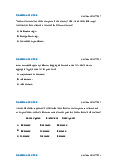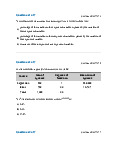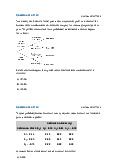














Preview text:
Question #1 of 49 Question ID: 1377409
A good for which consumers exhibit a negative income effect that is smaller than the
substitution effect is most accurately described as a(n): A) Gien good. B) inferior good. C) Veblen good. Question #2 of 49 Question ID: 1377412
A distinction between Giffen goods and Veblen goods is that:
demand curves for Gien goods slope upward, while demand curves for Veblen A) goods slope downward.
B) Gien goods are inferior goods, while Veblen goods are not inferior goods.
C) the substitution eect is positive for a Veblen good but negative for a Gien good. Question #3 of 49 Question ID: 1377408
Which of the following is most likely to cause a decrease in the consumption of a good in
response to a decline in the price of the good? A) Income eect. B) Substitution eect. C) Law of demand. Question #4 of 49 Question ID: 1377401
The price of milk in a country increases from €1.00 per liter to €1.10 per liter, and the
quantity supplied does not change. This suggests the elasticity of the short-run supply of
milk in this country is equal to:
A) zero, and supply is perfectly inelastic.
B) innity, and supply is perfectly elastic.
C) innity, and supply is perfectly inelastic. Question #5 of 49 Question ID: 1377381
If the price elasticity of demand is –2 and the price of the product decreases by 5%, the quantity demanded will: A) increase 10%. B) decrease 2.5%. C) increase 7%. Question #6 of 49 Question ID: 1377416
Under perfect competition, if the price of a firm's product is below its average total cost, in the short run the firm should:
A) increase the product price to at least cover its average total cost.
B) shut down, but operate in the long run if it is covering its variable costs.
C) operate if it is covering its variable costs. Question #7 of 49 Question ID: 1377384
If quantity demanded increases 20% when the price drops 2%, this good exhibits:
A) elastic, but not perfectly elastic, demand. B) perfectly inelastic demand.
C) inelastic, but not perfectly inelastic, demand. Question #8 of 49 Question ID: 1377388
If quantity demanded increases 15% when the price drops 1%, demand for this good:
A) elastic, but not perfectly elastic.
B) inelastic, but not perfectly inelastic. C) perfectly elastic. Question #9 of 49 Question ID: 1377387
For a linear demand curve, at the price where elasticity is -2.0, reducing prices will:
A) decrease total revenue and we are not at the point of maximum total revenue.
B) increase total revenue and we are at the point of maximum total revenue.
C) increase total revenue and we are not at the point of maximum total revenue. Question #10 of 49 Question ID: 1377410
A decrease in the price of Good Y can result in a decrease of the quantity of Good Y
demanded by consumers if the substitution effect:
A) and the income eect are negative.
B) is positive and the income eect is negative and larger than the substitution eect.
C) is negative and larger than the positive income eect. Question #11 of 49 Question ID: 1377414
A firm in a perfectly competitive industry that seeks to maximize profit is most likely to
continue production in the short run as long which of the following conditions exists? Price is equal to or greater than: A) average xed cost. B) average variable costs. C) marginal cost. Question #12 of 49 Question ID: 1377425
Based on the concept of diminishing returns, as the quantity of output increases, the short-
run marginal costs of production eventually: A) fall at a decreasing rate. B) rise at a decreasing rate. C) rise at an increasing rate. Question #13 of 49 Question ID: 1377398
The percent change in demand for a good divided by the percent change in the price of another good is known as the: A) price elasticity of demand.
B) cross price elasticity of demand.
C) income elasticity of demand. Question #14 of 49 Question ID: 1377396
Income elasticity is defined as the:
percentage change in the quantity demanded divided by the percentage change in A) income.
B) change in quantity demanded divided by the change in income.
percentage change in income divided by the percentage change in the quantity C) demanded. Question #15 of 49 Question ID: 1377421
The upward sloping segment of a long-run average total cost curve represents the existence of: A) diseconomies of scale. B) economies of scale. C) eciencies of scale. Question #16 of 49 Question ID: 1377413
When household incomes go down and the quantity of a product demanded goes up, the product is: A) a normal good. B) a Veblen good. C) an inferior good. Question #17 of 49 Question ID: 1377379
A good is most likely to demonstrate higher price elasticity of demand:
if it represents a small portion of the consumer’s budget, than if it represents a large A) portion.
B) in the long run than the short run.
when there are few substitutes for the good, than when there are many good C) substitutes. Question #18 of 49 Question ID: 1377422
A firm is operating in a perfectly competitive market. Market price is greater than average
variable cost (AVC) but lower than average total cost (ATC). Which of the following statements is most accurate?
The rm should continue to produce and sell its product in the short run but not in A)
the long run, unless the price increases.
The rm should decrease its production in the short run in order to increase price B)
and either reduce losses or produce prots.
If the owner thinks the price eventually will exceed ATC, the rm should shut down C)
its operations temporarily and resume when price exceeds ATC. Question #19 of 49 Question ID: 1377391
If the price of World Cup Soccer tickets increases from $40 a ticket to $50 a ticket and the
quantity demanded of tickets stays the same, demand for the tickets is:
A) elastic, but not perfectly elastic.
B) inelastic, but not perfectly inelastic. C) perfectly inelastic. Question #20 of 49 Question ID: 1377420
Which of the following most accurately describes economies of scale? Economies of scale:
A) are dependent on short-run average costs.
B) increase at a decreasing rate.
C) occur when long-run unit costs fall as output increases. Question #21 of 49 Question ID: 1377393
If the price elasticity of demand for a good is –4.0, then a 10% increase in price would result in a:
A) 10% decrease in the quantity demanded.
B) 4% decrease in the quantity demanded.
C) 40% decrease in the quantity demanded. Question #22 of 49 Question ID: 1377383
If the price elasticity of a linear demand curve is –1 at the current price, an increase in price will lead to: A) no change in total revenue.
B) an increase in total revenue.
C) a decrease in total revenue. Question #23 of 49 Question ID: 1377394
If the price elasticity of demand is –1.5 and a change in the price of the product increases
the quantity demanded by 4%, then what is the percent change in price? A) –0.375%. B) –2.667%. C) –6.000%. Question #24 of 49 Question ID: 1377418
Suppose a price-taker firm produces baseball bats that sell at a price of $100 each. This
firm's average total cost at the current level of production is $150 per bat, and the average
fixed cost is $40 per bat. Which of the following statements is most accurate regarding this firm? They should:
A) continue producing baseball bats because they are covering their xed costs.
shut down in the short run because their average total cost is greater than their B) price.
shut down in the short run because their average variable cost is greater than their C) price. Question #25 of 49 Question ID: 1377400
The demand for a product tends to be price inelastic if:
A) few good complements for the product are available.
B) people spend a large share of their income on the product.
C) few good substitutes for the product are available. Question #26 of 49 Question ID: 1377424
According to the law of diminishing returns, doubling the number of salespeople for a firm will most likely result in:
decreasing the total sales of the rm as a result of competition amongst A) salespeople.
increasing the total sales of the rm and reducing the average sales per B) salesperson.
C) doubling the total sales of the rm. Question #27 of 49 Question ID: 1377403
The daily demand curve for olive oil (in liters) for a particular distributor is estimated as: Price = 20 − Q / 150 olive oil olive oil
At a price of $10 per liter, the price elasticity of demand for olive oil is closest to: A) −0.007. B) −1.000. C) −1.300. Question #28 of 49 Question ID: 1377428
At a fixed level of capital, output increases as the quantity of labor increases, but at a
decreasing rate. This phenomenon is an example of: A) diminishing costs to labor.
B) diminishing returns to capital.
C) diminishing returns to labor. Question #29 of 49 Question ID: 1377386
If a good has elastic demand, a small percentage price increase will cause:
A) a larger percentage increase in the quantity demanded.
B) a larger percentage decrease in the quantity demanded.
C) a smaller percentage increase in the quantity demanded. Question #30 of 49 Question ID: 1377405
With respect to utility theory, the income effect for a decrease in the price of a good:
A) may increase or decrease consumption of the good.
B) will decrease consumption of the good.
C) will increase consumption of the good. Question #31 of 49 Question ID: 1377402
When two goods are complements, the cross elasticity of demand is:
A) negative, and for substitutes the cross price elasticity of demand is positive.
B) positive, and for substitutes the cross price elasticity of demand is negative.
C) negative, and for substitutes the cross price elasticity of demand is negative. Question #32 of 49 Question ID: 1377385
The primary factors that influence the price elasticity of demand for a product are:
changes in consumers' incomes, the time since the price change occurred, and the A)
availability of substitute goods.
the availability of substitute goods, the time that has elapsed since the price of the
B) good changed, and the proportions of consumers' budgets spent on the product.
the proportions of consumers' budgets spent on the product, the size of the shift in C)
the demand curve for a product, and changes in consumers' price expectations. Question #33 of 49 Question ID: 1377399
Gene Bawerk, an economics professor, is lecturing on the factors that influence the price
elasticity of demand. He makes the following assertions:
Statement 1: For most goods, demand is more elastic in the long run than the short run.
Statement 2: Demand for a good becomes more elastic when a close substitute
for it becomes available on the market.
With respect to Bawerk's statements:
A) only statement 1 is correct.
B) only statement 2 is correct. C) both are correct. Question #34 of 49 Question ID: 1377415
If the price of its product is less than its average total cost in the long run, a firm operating
under perfect competition should: A) shut down.
B) keep operating only if it is covering its variable costs.
C) keep operating and attempt to eliminate its xed costs. Question #35 of 49 Question ID: 1377392
If the demand curve for a given product is a straight line with a slope of –5, this indicates that: A) demand is unit elastic.
B) elasticity is constant along the demand curve.
C) demand is more elastic at higher prices. Question #36 of 49 Question ID: 1377382
Income elasticity is defined as the percentage change in:
A) income divided by the percentage change in the quantity demanded.
B) quantity demanded divided by the percentage change in income.
C) quantity demanded divided by the percentage change in the price of the product. Question #37 of 49 Question ID: 1377390
When demand for a good is relatively inelastic, a higher price will:
A) lead to an increase in total expenditures for the good.
B) fail to reduce the quantity demanded for the good.
C) have no impact on the demand for the good. Question #38 of 49 Question ID: 1377395
If the price elasticity of demand is -1.5 and the price of the product increases 2%, the quantity demanded will:
A) decrease approximately 0.75%.
B) decrease approximately 1.5%. C) decrease approximately 3%. Question #39 of 49 Question ID: 1377419
A firm that is experiencing diseconomies of scale should: A) decrease its plant size.
B) decrease output in the short run. C) shut down in the long run. Question #40 of 49 Question ID: 1377411
A good is considered an inferior good if it exhibits a negative: A) elasticity of demand. B) income eect. C) substitution eect. Question #41 of 49 Question ID: 1377397
Price elasticity of demand is most accurately defined as the change in:
A) quantity demanded in response to a change in income.
B) quantity demanded in response to a change in market price.
C) market price in response to a change in the quantity demanded. Question #42 of 49 Question ID: 1377389
If a good has elastic demand, a small price decrease will cause:
A) a larger decrease in the quantity demanded.
B) a larger increase in quantity demanded.
C) no change in the quantity demanded. Question #43 of 49 Question ID: 1377407
When the price of a good decreases, how do the income effect and the substitution effect
change the quantity demanded of the good?
A) Both the income eect and the substitution eect increase the quantity demanded.
The income eect increases the quantity consumed, but the substitution eect may B)
increase or decrease the quantity demanded.
The substitution eect increases the quantity demanded, but the income eect may C)
increase or decrease the quantity demanded. Question #44 of 49 Question ID: 1377380
The cross price elasticity of demand for a substitute good and the income elasticity for an inferior good are: Cross Income elasticity elasticity A) > 0 < 0 B) < 0 > 0 C) < 0 < 0 Question #45 of 49 Question ID: 1377423
Which of the following statements regarding diminishing marginal returns is most accurate?
A) As the quantity produced rises, costs begin to rise at an increasing rate.
B) The total cost curve arches downward.
C) As the quantity produced rises, costs begin to rise at a decreasing rate. Question #46 of 49 Question ID: 1377404
A company has estimated that the price elasticity of demand for its output is –1.1. If the
company increases the price of its product by 5%, it is most likely that:
A) both total revenue and prots will decrease.
B) total revenue will decrease but prots may increase.
C) total revenue will increase but prots may decrease. Question #47 of 49 Question ID: 1377426
The law of diminishing returns states that at some point as:
less of a resource are devoted to production, holding the quantity of other inputs
A) constant, the output will decrease, but at an increasing rate.
more of a resource is devoted to production, holding the quantity of other inputs B)
constant, at some point output will begin to decrease.
more of a resource is devoted to production, holding the quantity of other inputs C)
constant, the output will increase, but at a decreasing rate. Question #48 of 49 Question ID: 1377427
The law of diminishing returns states that for a given production process, as more and more
of a resource (such as labor) are added, holding the quantities of other resources fixed:
A) output increases at a decreasing rate.
B) cost declines at a decreasing rate.
C) cost declines at an increasing rate. Question #49 of 49 Question ID: 1377406
With respect to utility theory, the substitution effect for a decrease in the price of a good:
A) will increase consumption of the good.
B) will decrease consumption of the good.
C) may increase or decrease consumption of the good.



